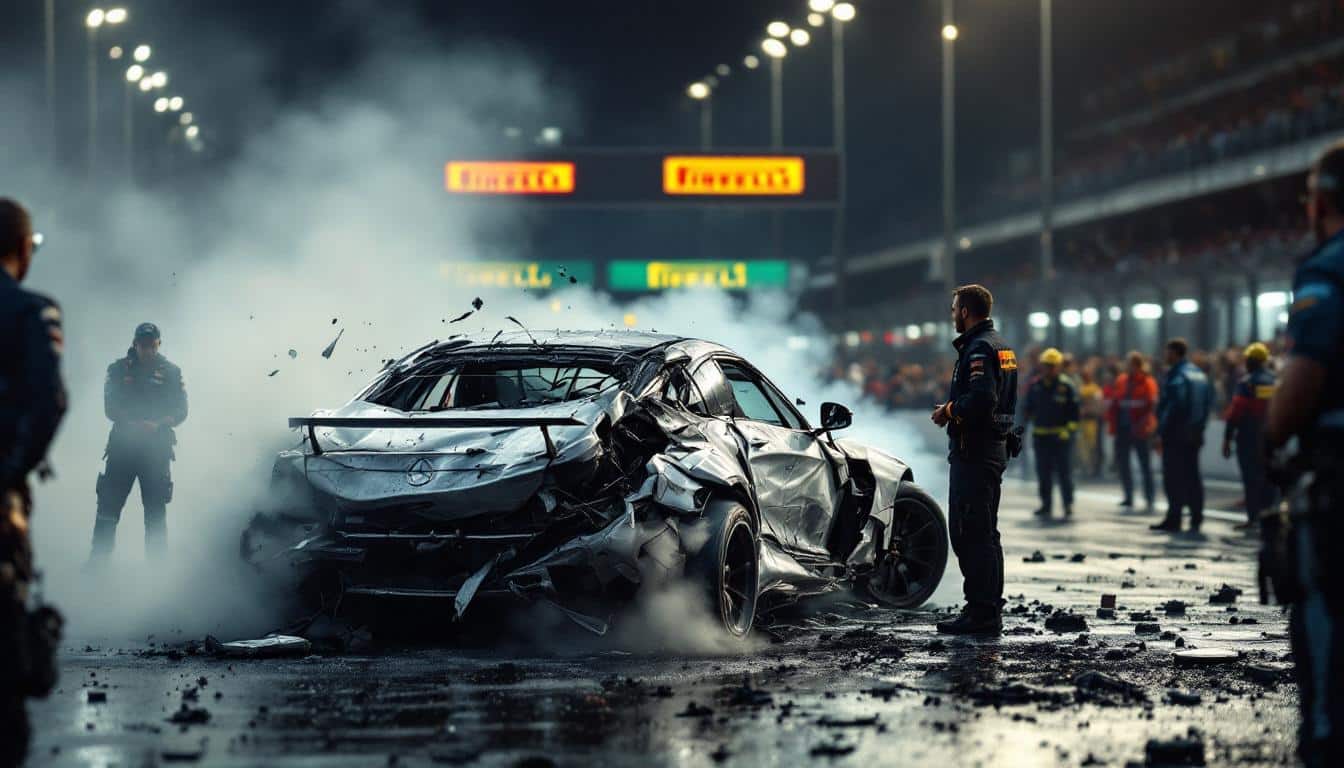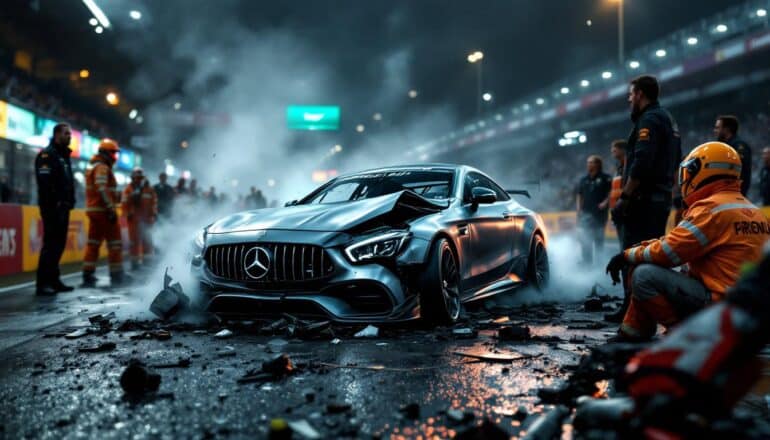The roar of the engines, the smell of burnt rubber, and the rush of adrenaline electrify the atmosphere during a Formula 1 race.
But sometimes, the race doesn’t go as planned, leading to dramatic incidents that capture the attention of fans and analysts alike.
Such was the case at Silverstone during the British Grand Prix, where Kimi Antonelli faced a devastating crash that left his Mercedes wrecked.
As the competition heated up on Lap 18, visibility took a nosedive due to heavy spray at Copse corner, and the unsuspecting Isack Hadjar collided forcefully with Antonelli’s car. The aftermath was catastrophic for both drivers, with Antonelli being ordered to retire his machine by engineer Peter Bonnington. Reflecting on the incident, Antonelli expressed his frustrations, noting that he lost a staggering amount of downforce due to the damage, impacting his ability to control the vehicle effectively. The collision was a harsh reminder of the unpredictable nature of racing, where conditions can change in the blink of an eye, and fortunes can shift dramatically. His experience resonated deeply within the motorsport community, sparking conversations about safety and strategy amidst challenging weather conditions.

The recent British Grand Prix witnessed a stunning turn of events as Kimi Antonelli revealed the catastrophic damage inflicted on his Mercedes after a harrowing collision with Isack Hadjar at Silverstone. On lap 18, Antonelli’s race took a disastrous turn when Hadjar, caught off guard by heavy spray, crashed into the rear of his car at the notorious Copse corner. This article delves into the details surrounding this shocking incident, shedding light on the mechanics of the crash and its ramifications for Antonelli’s season.
During the race, Antonelli’s engineer, Peter Bonnington, quickly informed him to retire from the race, marking Antonelli’s fourth Did Not Finish (DNF) in just six races. It was a moment of despair for the Italian driver, who voiced his frustrations to the media, stating that he was losing a staggering 100 points of downforce due to the extensive damage caused by the accident. The implications of such a loss in performance are profound, particularly in a field where fractions of a second can determine victory or defeat.
Moreover, to put Antonelli’s misfortune into perspective, we can draw comparisons with Lewis Hamilton’s experience at the Canadian Grand Prix. Hamilton lost around 20 points of downforce after colliding with a groundhog, which translated to roughly half a second per lap of performance loss. Conversely, Antonelli faced a monumental decrease in speed, estimated at approximately 2.5 seconds per lap due to his vehicle’s compromised aerodynamics. This raises questions about vehicle safety and the effectiveness of current regulations in protecting drivers during such unpredictable racing conditions.
What went wrong during the race?
The elements played a critical role in this incident, with visibility drastically reduced due to heavy rain. Antonelli explained to reporters, including those from RacingNews365, the challenges he faced. He explained how on lap one, his decision to pit proved detrimental when a Virtual Safety Car (VSC) was deployed, preventing him from adequately heating his tires upon returning to the track. The compromised visibility caused by the rain meant that he struggled to assess the racing line, resulting in a precarious situation leading up to the crash.
While addressing the aftermath of the incident, Antonelli expressed a feeling of helplessness. The visibility at low speeds was already troubling; however, the drivers were instructed to continue racing despite conditions that many believed were unsuitable. “I was a bit unsure about that because the visibility was still very poor at low speeds,” Antonelli stated, highlighting his concern over the decisions made during a pivotal moment in the race, indicating that the conditions could have warranted a more cautious approach by race officials.
Additionally, his sentiments were echoed by Hadjar, who suggested that the crash was “quite predictable” given the visibility challenges. Hadjar’s remark added to a growing list of opinions challenging the decision to resume racing under such conditions. With both drivers’ feedback, there seems to be a consensus that serious discussions need to take place regarding race safety and visibility standards.
How does this incident impact the championship standings?
The repercussions of a crash like that which occurred at Silverstone extend beyond just one race; the incident has significant implications for the championship standings. Antonelli’s retirement, his fourth of the season, diminishes his chances of climbing the leaderboard. With each race contributing points to the standings, accumulating DNFs can prove detrimental, not only in terms of score but also in terms of confidence and momentum for the driver and the team.
As the 2025 Formula 1 season approaches, fans are already speculating on how current incidents like Antonelli’s crash will shape team dynamics and championship tactics. Compounding this, with factions forming around driver performance and team strategies, Antonelli finds himself in a precarious position that could make the upcoming races even more competitive. Each race now becomes vital, as teams strategize to recover lost ground in the championship standings. The competitive environment is further heightened by ongoing discussions surrounding drivers potentially switching teams or taking on new roles, evidenced by the speculation surrounding stars like Max Verstappen and his future with Red Bull.
For an insightful analysis of the current standings post-Canadian Grand Prix, check out the current details surrounding each team’s performance, as many drivers look to capitalize on their rivals’ misfortunes.
What can be done to improve safety in challenging weather conditions?
The Silverstone crash raises questions about how formula racing can improve safety measures, particularly during extreme weather conditions. Drivers and teams have long called for enhanced visibility and track safety protocols when adverse weather conditions prevail. The focus must shift towards promoting a culture of safety, where race officials prioritize driver well-being and H2O, preventing misfortunes like Antonelli’s crash.
Championship officials may need to implement stricter guidelines for race conditions that account for visibility and track wetness. Measures could include mandatory delays or halts to races when visibility falls below a certain threshold. Furthermore, the development of advanced telemetry and real-time data transmission could allow teams to make informed decisions about tire choices and race strategy based on current track conditions, enhancing overall safety for the drivers.
Moreover, considering the increasing incidents linked to wet weather, the use of technology, such as augmented reality helmets providing drivers with enhanced environmental awareness, could revolutionize how racers navigate tricky conditions. This technological advancement could prove crucial in mitigating risks associated with visibility during sudden weather shifts.
In conclusion, as competitors reflect on the implications of Antonelli’s crash and the ensuing fallout, it serves as a stark reminder of the risks confronting modern racing. Embracing a comprehensive approach to safety will not only safeguard drivers but also enhance the spectacle of the sport itself, delivering thrilling motorsport action in a responsible manner.
For further insights into the evolving dynamics of Formula 1 and its most daring moments, stay tuned to the hottest updates and features!


